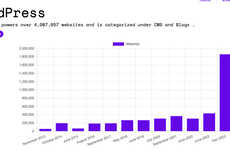
CloudFlare Protects & Speeds Up Websites Behind the Scenes
Marcus Daniels — July 24, 2012 — Tech
References: cloudflare & cloudflare
This series is brought to you by HP Elite. Find out more at hp.com/elite
As a continuation of a consulting series that we’re doing with our friends at The Next Web set up and VentureBeat advised on, today we’re profiling CloudFlare and its frictionless technology solution.
CloudFlare is ambitiously trying to solve some of the web’s most complex problems. Originating from previous work on tracking website threats with Project Honey Pot and winning a Harvard MBA business plan competition, CloudFlare is trying to build a faster, safer and smarter web, according to Matthew Prince, the company's CEO and co-founder.
If you are a website owner, you need to make your site safe and fast within a reasonable cost structure based on your business model. Small and medium-trafficked sites often don’t have the resources to do so as effectively as many of the industry’s giant portals. CloudFlare’s free service makes websites better by protecting them from an extensive range of online threats, optimizing their content across the Interwebs and increasing page load speeds. Yes, its primary solution is free, frictionless and scalable. Its revenue model includes both a freemium service offering and ads on error pages that redirect the users to value-add services.
What’s unique about this stealthy solution is that customers don’t require any software or hardware. Most of the company's work is done behind the scenes and is frictionless to its customers. Technically, the company routes web traffic through its globally distributed network to clean and filter it before delivering it to the customer’s website. Simply put, the CloudFlare solution blocks out attacks, spam and even speeds up performance substantially in most cases.
The company's growth has been phenomenal, with thousands of new clients each day. CloudFlare is currently serving up over 65 billion views a month, which is more traffic than the likes of Amazon, Twitter and Instagram combined! Impressively, much of its client growth has been based on word-of-mouth marketing. As the company's client list grows beyond small-medium businesses to include large enterprise customers, there is an opportunity to make its brand awareness pop even more in the crowded IT infrastructure space.
Our advice is to leverage the Immersive Branding Pro Trend that we have tracked in the past and apply it to CloudFlare's enterprise awareness campaigns to make its brand stand out among the competitive marketplace noise. We’ve seen many consumer-facing brands, such as Coca-Cola and Cadbury, go beyond strong visuals to creating a total brand experience in which the customer is completely immersed in a brand both online and offline. Now, more B2B brands are leveraging this trend, which would be a great fit to enhance CloudFlare’s current pitches to hosting partners at industry events.
Clearly, CloudFlare has the DNA, technology and venture-backed money in the bank to dominate its space, just like how Salesforce.com’s “No Software” immersive branding campaign created a new tech standard with an infectious brand message that implied the end of software both in its digital experience and prospect real-world interactions.
Tune in later this week as The Next Web summarizes CloudFlare and Venture Beat wraps up this series on Egnyte. We will conclude with CrowdTwist.
As a continuation of a consulting series that we’re doing with our friends at The Next Web set up and VentureBeat advised on, today we’re profiling CloudFlare and its frictionless technology solution.
CloudFlare is ambitiously trying to solve some of the web’s most complex problems. Originating from previous work on tracking website threats with Project Honey Pot and winning a Harvard MBA business plan competition, CloudFlare is trying to build a faster, safer and smarter web, according to Matthew Prince, the company's CEO and co-founder.
If you are a website owner, you need to make your site safe and fast within a reasonable cost structure based on your business model. Small and medium-trafficked sites often don’t have the resources to do so as effectively as many of the industry’s giant portals. CloudFlare’s free service makes websites better by protecting them from an extensive range of online threats, optimizing their content across the Interwebs and increasing page load speeds. Yes, its primary solution is free, frictionless and scalable. Its revenue model includes both a freemium service offering and ads on error pages that redirect the users to value-add services.
What’s unique about this stealthy solution is that customers don’t require any software or hardware. Most of the company's work is done behind the scenes and is frictionless to its customers. Technically, the company routes web traffic through its globally distributed network to clean and filter it before delivering it to the customer’s website. Simply put, the CloudFlare solution blocks out attacks, spam and even speeds up performance substantially in most cases.
The company's growth has been phenomenal, with thousands of new clients each day. CloudFlare is currently serving up over 65 billion views a month, which is more traffic than the likes of Amazon, Twitter and Instagram combined! Impressively, much of its client growth has been based on word-of-mouth marketing. As the company's client list grows beyond small-medium businesses to include large enterprise customers, there is an opportunity to make its brand awareness pop even more in the crowded IT infrastructure space.
Our advice is to leverage the Immersive Branding Pro Trend that we have tracked in the past and apply it to CloudFlare's enterprise awareness campaigns to make its brand stand out among the competitive marketplace noise. We’ve seen many consumer-facing brands, such as Coca-Cola and Cadbury, go beyond strong visuals to creating a total brand experience in which the customer is completely immersed in a brand both online and offline. Now, more B2B brands are leveraging this trend, which would be a great fit to enhance CloudFlare’s current pitches to hosting partners at industry events.
Clearly, CloudFlare has the DNA, technology and venture-backed money in the bank to dominate its space, just like how Salesforce.com’s “No Software” immersive branding campaign created a new tech standard with an infectious brand message that implied the end of software both in its digital experience and prospect real-world interactions.
Tune in later this week as The Next Web summarizes CloudFlare and Venture Beat wraps up this series on Egnyte. We will conclude with CrowdTwist.
Trend Themes
1. Friction-less Solutions - CloudFlare offers a frictionless, software-free solution to protect websites from a range of online threats and optimize content delivery, presenting an opportunity for other companies to develop similar solutions in different fields.
2. Immersive Branding - Using a trend of total brand experiences could enhance CloudFlare's brand awareness campaigns, as well as other business-to-business (B2B) brands in crowded IT infrastructure spaces.
3. Word-of-mouth Marketing - CloudFlare's explosive growth, driven by word-of-mouth marketing, highlights the importance of social networking and viral advertising in today's digital age and suggests an opportunity for businesses in other target markets to explore similar marketing strategies.
Industry Implications
1. Cybersecurity - CloudFlare's solution to cybersecurity makes use of a software-free approach, presenting an opportunity for companies in the same industry to explore low-maintenance solutions to cyber threats.
2. Web Hosting - CloudFlare's solution is designed to work with web hosting for small to medium-sized sites, presenting an opportunity for the industry to continue to develop such solutions based on dynamic customer needs to optimize performance.
3. Digital Advertising - CloudFlare's partnership with advertisers suggests an intersection of online safety and digital advertising that presents an opportunity for other companies in the field to explore similar revenue-generation models.
6.2
Score
Popularity
Activity
Freshness























